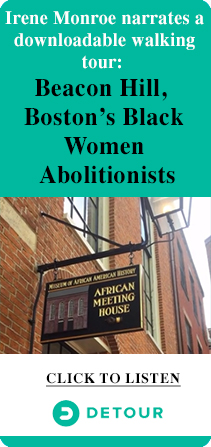Seldom do I see characters on the silver screen or on stage who represent me in non-stereotypical and non-heterosexist ways.
As a matter of fact, if you Google “black lesbians” or “black lesbians in film” you’ll get a plethora of porn sites to visit. And if you Google “black lesbian plays” the search comes up empty.
But Sharon Bridgforth has filled a void with her play “River See.”
“River See” tells a story that is unabashedly queer, unapologetically black, and quintessentially American. While Bridgforth’s characters are fictional the story’s very real.
In creating “River See” Bridgforth artistic impulse is influenced by the “The Black Arts Movement,” started in 1965—a month following the assassination of Malcolm X. Artists like Amiri Baraka, Nikki Giovanni, Maya Angelou, Ismael Reed, and Toni Morrison, just to name a few, did what The Harlem Renaissance writers did decades earlier—write black life into existence.
Bridgforth boldly writes into existence a narrative, and thereby a people, too often omitted from the canons of African American history—its LGBTQs. Her play completes Isabel Wilkerson’s groundbreaking and 2010 historical bestseller “The Warmth of Other Suns: The Epic Story of America’s Great Migration.”
Wilkerson’s book is about the migratory patterns—The Great Migration between 1910 -1930 and Second Great Migration between 1941-1970—of African Americans from the South to all points the hell out of it. To the Northeast, Midwest, and West between 1915 and 1970.
Wilkerson focuses her narrative on three people who are representative of different socioeconomics and regions of the South—Ida Mae Brandon Gladney, a free-spirited sharecropper’s wife who left Chickasaw County, Mississippi in the 1937 for Chicago; George Swanson Starling, an agricultural worker who left the citrus fields of Eustis, Florida for New York City in the 1945; and Robert Joseph Pershing Foster, a surgeon who couldn’t operate in white hospitals or on white patients who left Monroe, Louisiana for Los Angeles in 1953.
Bridgforth focuses her narrative on See, a young queer sister heading North to the Promised Land from the Mississippi Delta. See is representative of our culture’s outsiders—juking women, deviants, seers, and LGBTQs.
See is played by the beautiful, talented and accomplished actress Sonja Parks whose dynamic performance takes the audience on a spiritual journey. Parks helps us see who her character See sees—Lil NayNay, Grandma-Aunt Porkchopps, Big Suzi, Mr. Goodies, Mrs. Shine, Ms. Ada and she ole ass dog Lil Lady. These characters are eccentric, hilarious, humanly flawed in the places where we are and worldly-wise from the travails of life. As See heads North guided by her elders, moving spirits, whispering neighbors, and us — the audience—See traverses a world “where the living-the dead-the unborn/the past-the present-the future co-exist.” Without See’s story the history of the African American great migrations would incomplete.
How Bridgforth tells See’s story falls within both black women’s literary and artistic canons. See’s narrative has the poetic feel, energy and rawness of Ntozake Shange’s 1975 landmark stage play “for colored girls who have considered suicide/when the rainbow is enuf” and the African Diasporic cultural and religious aesthetic of Julie Dash’s 1991 “Daughters of the Dust.”
And like Shange and Dash, Bridgforth experiments with an unconventional narrative device that many sisters of the African Diasporic argue is the only way to aptly convey and capture the complexities of black women lives.
Shange’s narrative device is choreopoem, consisting of 20 poems about struggles and joys of black women choreographed to music.
The Unborn Child tells Dash’s narrative device—telling the story of the psychic and spiritual turmoil among the women of a Gullah clan of former slaves of the Sea Islands off the South Carolina-Georgia coast at the turn of the century, making the painful decision to migrate to the American mainland.
Bridgforth’s narrative device is a series blues stories set on a riverboat, employing the improvisational elements of jazz. With this narrative device Bridgforth infuses movement, singing, dance, ritual, storytelling, and audience participation as she stands in the midst of all the action while directing it. Her technique helps to illustrate there is structure and form in the telling of the narrative as well as focus and intentionality in See’s seemingly noisy, chaotic and peripatetic journey North.
With a paucity of plays by and about black lesbians, I hope Bridgforth’s play continues to find performance space.
The fact that Bridgforth’s queer play was performed in a church in the predominately black enclave of Uphams Corner of Dorchester is attributed to the brilliance of Abe Rybeck, Executive Artistic Director of The Theater of the Offensive. And with TTO’s goal to be “Out in Your Neighborhood” it has not only fostered more tolerance of its LGBTQ community, but it has also created a sacred space for the entire community to witness and to hear our stories on stage.



